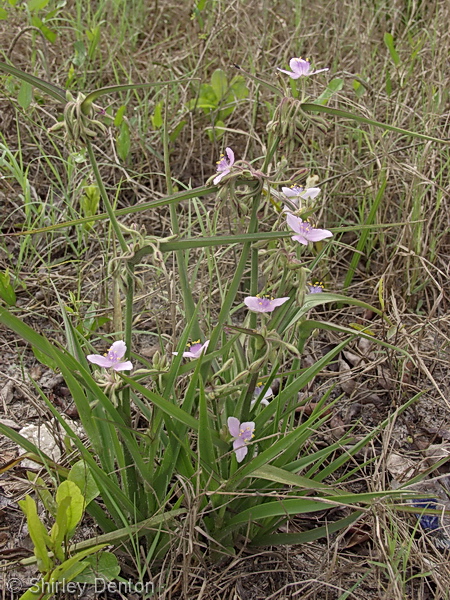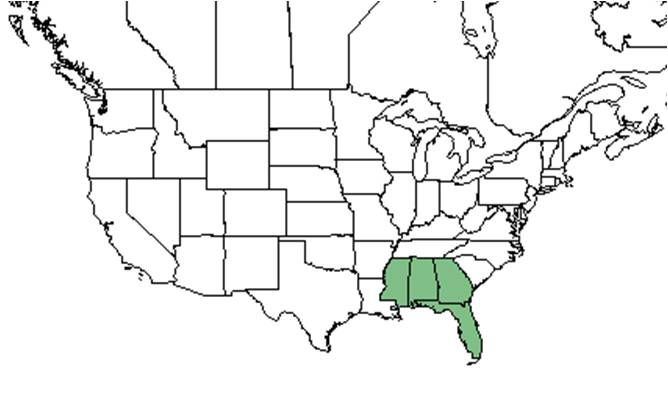Difference between revisions of "Tradescantia roseolens"
HaleighJoM (talk | contribs) (→Ecology) |
|||
| (32 intermediate revisions by 5 users not shown) | |||
| Line 18: | Line 18: | ||
}} | }} | ||
| − | Common | + | Common names: Longleaf spiderwort, Sandhill spiderwort |
==Taxonomic notes== | ==Taxonomic notes== | ||
| + | Synonym: ''Tradescantia longifolia'' Small.<ref>Weakley, A.S. 2015. Flora of the southern and mid-atlantic states. Working Draf of 21 May 2015. University of North Carolina at Chapel Hill, Chapel Hill, North Carolina.</ref> | ||
| + | |||
| + | The specific epithet ''roseolens'' is derived from the fragrant tea-rose smell emitted from the flower.<ref name="small">Small, J. K. (1924). "Plant Novelties from Florida." Bulletin of the Torrey Botanical Club 51(9): 379-393.</ref> | ||
| + | |||
==Description== | ==Description== | ||
<!-- Basic life history facts such as annual/perrenial, monoecious/dioecious, root morphology, seed type, etc. --> | <!-- Basic life history facts such as annual/perrenial, monoecious/dioecious, root morphology, seed type, etc. --> | ||
A description of ''Tradescantia roseolens'' is provided in [http://www.efloras.org/florataxon.aspx?flora_id=1&taxon_id=222000432 The Flora of North America]. | A description of ''Tradescantia roseolens'' is provided in [http://www.efloras.org/florataxon.aspx?flora_id=1&taxon_id=222000432 The Flora of North America]. | ||
| + | |||
| + | ''T. roseolens'' is similar to ''T. longifolia''; however, ''T. roseolens'' can be differentiated by having smaller fragrant flowers and glandless stems.<ref name="small"/> | ||
==Distribution== | ==Distribution== | ||
| + | ''Tradescantia roseolens'' is endemic to an area from southern South Carolina to peninsular Florida, but the majority is found in Florida.<ref>Sorrie, B. A. and A. S. Weakley 2001. Coastal Plain valcular plant endemics: Phytogeographic patterns. Castanea 66: 50-82.</ref> It is listed as imperiled in Georgia.<ref name="natureserve">[[http://explorer.natureserve.org/servlet/NatureServe?searchName=Tradescantia+roseolens]]NatureServe. Accessed: March 21, 2016</ref> | ||
| + | |||
==Ecology== | ==Ecology== | ||
===Habitat=== <!--Natural communities, human disturbed habitats, topography, hydrology, soils, light, fire regime requirements for removal of competition, etc.--> | ===Habitat=== <!--Natural communities, human disturbed habitats, topography, hydrology, soils, light, fire regime requirements for removal of competition, etc.--> | ||
| − | ''T. roseolens'' | + | Habitats of ''T. roseolens'' include Florida rosemary balds, oak scrubs, hammocks, sandhills, pinewoods, and roadsides.<ref name="eol">[[http://eol.org/pages/523745/details]]Encyclopedia of Life. Accessed: March 21, 2016</ref><ref name="fsu">Florida State University Robert K. Godfrey Herbarium database. URL: http://herbarium.bio.fsu.edu. Last accessed: November 2015. Collectors: Steven P. Christman, Robin B. Huck. States and Counties: Florida: Highlands. Compiled by Tall Timbers Research Station and Land Conservancy.</ref> Associated species include ''Ceratiola, Quercus inopina, Q. geminata'' and ''Q. chapmanii''. In Florida rosemary balds, ''T. roseolens'' was found to be positively associated with patch isolation.<ref name="quintana">Quintana-Ascencio, P. F. and E. S. Menges (1996). "Inferring Metapopulation Dynamics from Patch-Level Incidence of Florida of Scrub Plants." Conservation Biology 10(4): 1210-1219.</ref> |
| + | ===Phenology=== <!--Timing off flowering, fruiting, seed dispersal, and environmental triggers. Cite PanFlora website if appropriate: http://www.gilnelson.com/PanFlora/ --> | ||
| + | Flowers February through March.<ref name="eol"/><ref>Nelson, G. [http://www.gilnelson.com/ PanFlora]: Plant data for the eastern United States with emphasis on the Southeastern Coastal Plains, Florida, and the Florida Panhandle. www.gilnelson.com/PanFlora/ Accessed: 19 MAY 2021</ref> | ||
| + | <!--===Seed dispersal===--> | ||
| + | <!--===Seed bank and germination===--> | ||
| − | |||
| − | |||
| − | |||
===Fire ecology=== <!--Fire tolerance, fire dependence, adaptive fire responses--> | ===Fire ecology=== <!--Fire tolerance, fire dependence, adaptive fire responses--> | ||
| + | Long periods of fire suppression can hinder the response of ephemeral, resprouting/seeding herbs such as ''T. roseolens''. Fire has been observed to revitalize populations in recently burned sites.<ref name="abrahamson">Abrahamson, W. G. and C. R. Abrahamson (1996). "Effects of Fire on Long-Unburned Florida Uplands." Journal of Vegetation Science 7(4): 565-574.</ref> | ||
| + | |||
===Pollination=== | ===Pollination=== | ||
| − | The | + | The stamens have scent-producing hairs that attract pollinators. ''T. roseolens'' has 6 pollen baring anthers, allowing several flies to feed simultaneously on one flower. Deyrup (1988) observed that ''P. punctipennis'' was the most abundant insect on ''T. roseolens'' at Archbold Biological Station. Additionally, sweat bees such as ''Lasioglossum nymphalis, L. placidensis'' and ''L. puteulanum'' (family Halictidae) were observed visiting flowers of ''Tradescantia roseolens'' at the Archbold Biological Station:<ref name="Deyrup 2015">Deyrup, M.A. and N.D. 2015. Database of observations of Hymenoptera visitations to flowers of plants on Archbold Biological Station, Florida, USA.</ref> |
| + | <!--===Herbivory and toxicology=== <!--Common herbivores, granivory, insect hosting, poisonous chemicals, allelopathy, etc.--> | ||
| + | <!--===Diseases and parasites===--> | ||
| − | + | ==Conservation, cultivation, and restoration== | |
| + | |||
| + | ==Cultural use== | ||
| + | The stems and leaves are edible.<ref> Fernald, et al. 1958. Edible Plants of Eastern North America. Harper and Row Publishers, New York.</ref> | ||
| − | |||
| − | |||
| − | |||
| − | |||
==Photo Gallery== | ==Photo Gallery== | ||
<gallery widths=180px> | <gallery widths=180px> | ||
</gallery> | </gallery> | ||
| − | |||
==References and notes== | ==References and notes== | ||
| − | Deyrup, M.A. | + | Deyrup, M. A. (1988). "Pollen-Feeding in Poecilognathus punctipennis (Diptera: Bombyliidae)." The Florida Entomologist 71(4): 597-605. |
| − | |||
| − | |||
Latest revision as of 07:22, 18 July 2022
| Tradescantia roseolens | |
|---|---|

| |
| Photo by Shirley Denton (Copyrighted, use by photographer’s permission only), Nature Photography by Shirley Denton | |
| Scientific classification | |
| Kingdom: | Plantae |
| Division: | Magnoliophyta - Flowering plants |
| Class: | Liliopsida – Monocotyledons |
| Order: | Commelinales |
| Family: | Commelinaceae |
| Genus: | Tradescantia |
| Species: | T. roseolens |
| Binomial name | |
| Tradescantia roseolens Small | |

| |
| Natural range of Tradescantia roseolens from USDA NRCS Plants Database. | |
Common names: Longleaf spiderwort, Sandhill spiderwort
Contents
Taxonomic notes
Synonym: Tradescantia longifolia Small.[1]
The specific epithet roseolens is derived from the fragrant tea-rose smell emitted from the flower.[2]
Description
A description of Tradescantia roseolens is provided in The Flora of North America.
T. roseolens is similar to T. longifolia; however, T. roseolens can be differentiated by having smaller fragrant flowers and glandless stems.[2]
Distribution
Tradescantia roseolens is endemic to an area from southern South Carolina to peninsular Florida, but the majority is found in Florida.[3] It is listed as imperiled in Georgia.[4]
Ecology
Habitat
Habitats of T. roseolens include Florida rosemary balds, oak scrubs, hammocks, sandhills, pinewoods, and roadsides.[5][6] Associated species include Ceratiola, Quercus inopina, Q. geminata and Q. chapmanii. In Florida rosemary balds, T. roseolens was found to be positively associated with patch isolation.[7]
Phenology
Flowers February through March.[5][8]
Fire ecology
Long periods of fire suppression can hinder the response of ephemeral, resprouting/seeding herbs such as T. roseolens. Fire has been observed to revitalize populations in recently burned sites.[9]
Pollination
The stamens have scent-producing hairs that attract pollinators. T. roseolens has 6 pollen baring anthers, allowing several flies to feed simultaneously on one flower. Deyrup (1988) observed that P. punctipennis was the most abundant insect on T. roseolens at Archbold Biological Station. Additionally, sweat bees such as Lasioglossum nymphalis, L. placidensis and L. puteulanum (family Halictidae) were observed visiting flowers of Tradescantia roseolens at the Archbold Biological Station:[10]
Conservation, cultivation, and restoration
Cultural use
The stems and leaves are edible.[11]
Photo Gallery
References and notes
Deyrup, M. A. (1988). "Pollen-Feeding in Poecilognathus punctipennis (Diptera: Bombyliidae)." The Florida Entomologist 71(4): 597-605.
- ↑ Weakley, A.S. 2015. Flora of the southern and mid-atlantic states. Working Draf of 21 May 2015. University of North Carolina at Chapel Hill, Chapel Hill, North Carolina.
- ↑ 2.0 2.1 Small, J. K. (1924). "Plant Novelties from Florida." Bulletin of the Torrey Botanical Club 51(9): 379-393.
- ↑ Sorrie, B. A. and A. S. Weakley 2001. Coastal Plain valcular plant endemics: Phytogeographic patterns. Castanea 66: 50-82.
- ↑ [[1]]NatureServe. Accessed: March 21, 2016
- ↑ 5.0 5.1 [[2]]Encyclopedia of Life. Accessed: March 21, 2016
- ↑ Florida State University Robert K. Godfrey Herbarium database. URL: http://herbarium.bio.fsu.edu. Last accessed: November 2015. Collectors: Steven P. Christman, Robin B. Huck. States and Counties: Florida: Highlands. Compiled by Tall Timbers Research Station and Land Conservancy.
- ↑ Quintana-Ascencio, P. F. and E. S. Menges (1996). "Inferring Metapopulation Dynamics from Patch-Level Incidence of Florida of Scrub Plants." Conservation Biology 10(4): 1210-1219.
- ↑ Nelson, G. PanFlora: Plant data for the eastern United States with emphasis on the Southeastern Coastal Plains, Florida, and the Florida Panhandle. www.gilnelson.com/PanFlora/ Accessed: 19 MAY 2021
- ↑ Abrahamson, W. G. and C. R. Abrahamson (1996). "Effects of Fire on Long-Unburned Florida Uplands." Journal of Vegetation Science 7(4): 565-574.
- ↑ Deyrup, M.A. and N.D. 2015. Database of observations of Hymenoptera visitations to flowers of plants on Archbold Biological Station, Florida, USA.
- ↑ Fernald, et al. 1958. Edible Plants of Eastern North America. Harper and Row Publishers, New York.